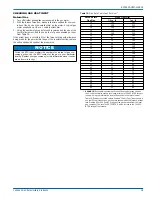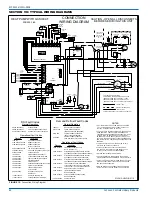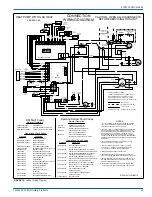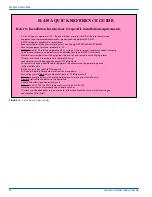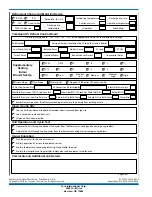
5132210-UIM-H-0916
16
Johnson Controls Unitary Products
GAS HEATING SEQUENCE OF OPERATION
Pressure Switch Proving
The control board energizes the induced draft motor and waits for the
pressure switch to close. When the pressure switch closes, the control
begins Pre-purge period. If the call for heat is removed, the control de-
energizes the inducer without post-purge and returns to standby.
If the pressure switch does not close within 5 seconds of inducer ener-
gizing, the control board flashes “3” on the LED. If the pressure switch
does not close within 60 seconds of inducer energizing, the control
shuts off the inducer for 60 seconds, then energizes the inducer for
another 60 seconds in an attempt to close the pressure switch. This
cycle continues indefinitely until either the pressure switch is proved
closed, or the call for heat ends.
Pre-purge
The control board monitors the pressure switch and ensures it remains
closed during pre-purge. If the pressure switch opens, the control goes
back to pressure switch proving mode. The control waits for a 15 sec-
ond pre-purge period, then begins the ignition trial.
Ignition Trial Period
The control board energizes the gas valve and spark outputs for a 5
second Ignition trial. The control de-energizes the spark when flame is
sensed and enters a flame stabilization period.
If flame is not established within the ignition trial period, the control de-
energizes the spark and gas valve and begins an inter-purge period
before attempting another ignition trial.
If the call for heat is removed during an ignition trial period, the control
immediately de-energizes spark and gas. The control runs the inducer
motor through a post purge period before de-energizing.
If the pressure switch opens during an ignition trial period, the control
immediately de-energizes spark and gas. The control begins pressure
switch proving before an inter-purge and reignition attempt.
Heat Blower On Delay
The control board waits for 30 seconds and then energizes the indoor
blower heat speed. Blower on delay time begins at the start of flame
proving period in the trial for ignition.
If the thermostat demand for heat is removed, the control de-energizes
the gas valve, energizes the blower on heat speed and initiates a post
purge and heat blower off delay.
Main Burner Operation
The control board keeps the main gas valve and induced draft motor
energized while continuously monitoring the call for heat, pressure
switch, and flame status.
If the call for heat (W) is removed, the control de-energizes the gas
valve, begins post purge and heat blower off delay.
If the pressure switch opens, the control de-energizes the gas valve
and begins pressure switch proving mode.
If flame is removed, the control de-energizes the gas valve within 2.0
seconds and counts the flame loss. If flame has been lost less than 5
times, the control attempts re-ignition after a 15 second inter-purge
period. If flame has been lost more than 5 times within the same call for
heat, the control board locks out flashing “8” on the LED. Post Purge
The control board runs the induced draft motor for a 15 second post-
purge period, and then de-energizes the inducer. If a call for heat
occurs during post-purge, the control finishes the postpurge, and imme-
diately begins the next ignition sequence.
Heat Blower Off Delay
After a heating sequence the control board de-energizes the indoor
blower motor after a delay time as selected by a movable shunt (60, 90,
120 or 180 seconds). Blower off timing begins when the thermostat is
satisfied and removes (W) the call for heat. The control returns to
standby when the blower off delay is complete.
If the thermostat call for heat returns before the blower off delay is com-
plete, the control begins an ignition sequence with prepurge while the
blower off delay continues.
Lockout
While in lockout, the control board keeps the main gas valve and
induced draft motor de-energized.
Lockouts due to failed ignition or flame losses may be reset by remov-
ing the call for heat (W) for more than 1 second, or by removing power
from the control for over 0.25 seconds. The control will automatically
reset lockout after 60 minutes.
Lockouts due to detected internal control faults will reset after 60 min-
utes or power interruption. Cooling operations are available during a
heating lockout.
High Temperature Limit Switch
Any time the high temperature limit switch is open less than 5 minutes
the control board will run the indoor blower motor on heat speed, run
the inducer, de-energize the gas valve, and flash “4” on the LED. When
the high temperature switch closes, the control will restart the ignition
sequence beginning with pre-purge.
If the limit switch has been open more than 5 minutes the control will
de-energize the inducer, continue to operate the indoor blower motor on
heat speed, and flash “11” on the LED
Rollout Switch
If the limit circuit is open for more than 15 minutes, the control board will
flash “5” on the LED. The blower output will be energized during an
open rollout condition.
If the rollout switch is reset, the control shall remain locked out until
power is removed or a call for heat (W) is removed.
Rollout switch lockout shall not reset automatically.
Power Interruptions
Power interruptions of any duration shall not cause lockout or any oper-
ation requiring manual intervention.
Flame present with Gas off
If flame is sensed for longer than 4.0 seconds during a period when the
gas valve should be closed, the control will enter lockout flashing “1” on
the LED. The control will energize the inducer blower while the flame is
sensed.
Table 17:
Fault Codes
Description
STATUS LED
High -pressure switch fault (not in lockout yet)
2 Flashes
System in high-pressure switch lockout (last mode of
operation was normal compressor)
3 Flashes
System in high-pressure switch lockout (last mode of
operation was defrost)
4 Flashes
System in loss of charge switch lockout (last mode of
operation was normal compressor)
5 Flashes
Low Voltage (<19.2VAC) preventing further relay
outputs for > 2 seconds
6 Flashes
Low Voltage (<16VAC) stopped current relay outputs
for > 2 seconds
7 Flashes
Liquid Line sensor failure (Open or Shorted)
8 Flashes
Outdoor ambient sensor failure (Open or Shorted)
9 Flashes
Control Failure
10 Flashes


















